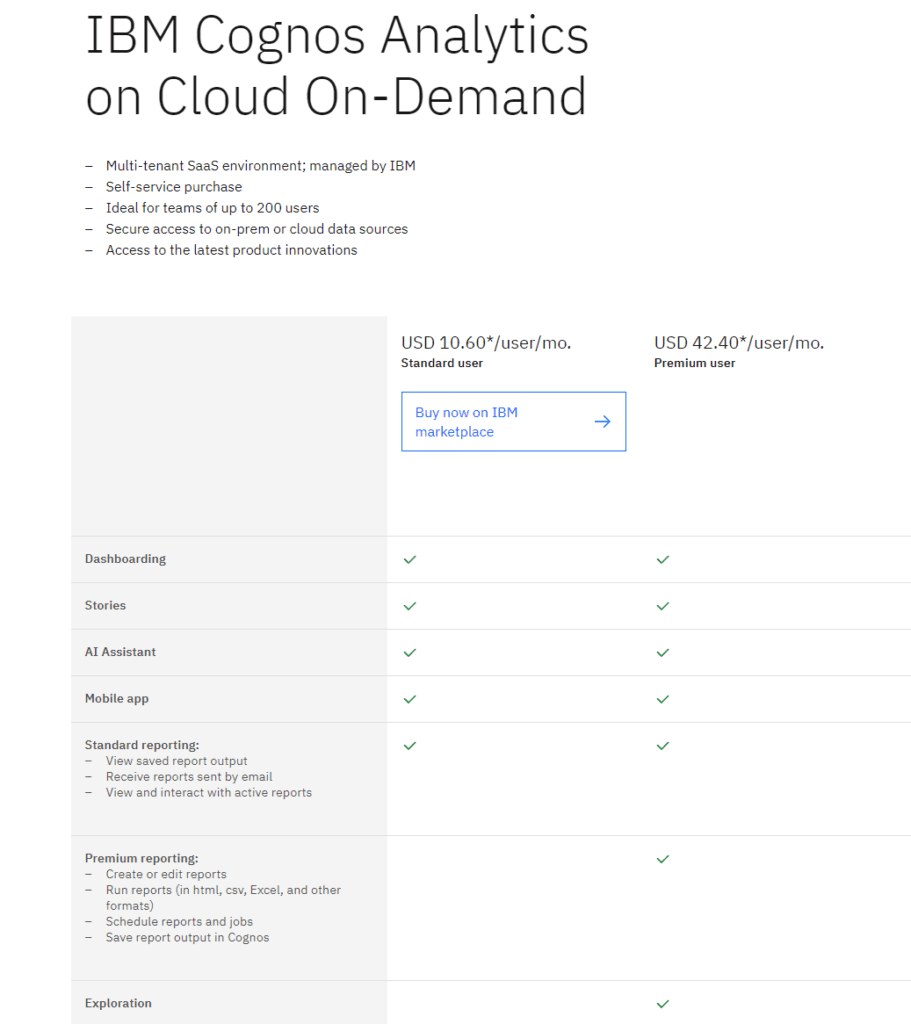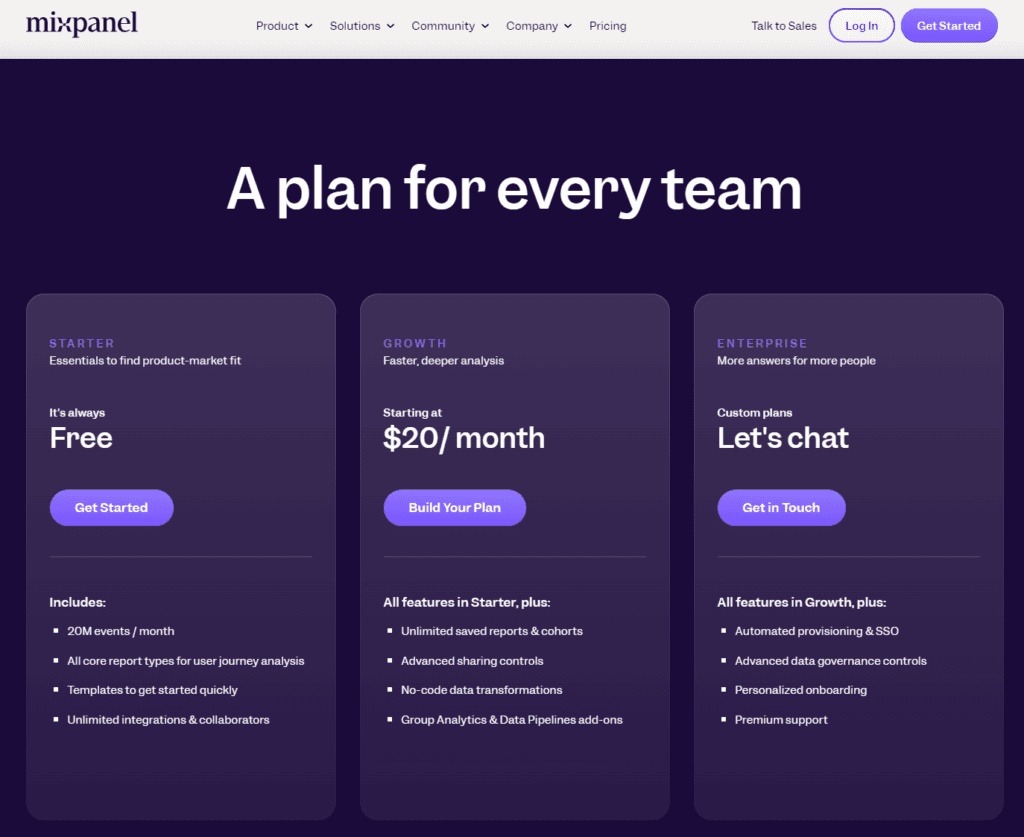Choosing the right analytics tool for your business is like picking out a new smartphone. You want something that fits just right, matches your style, and, most importantly, can keep up with your demands. In the digital realm, where data is king, having the right analytics tool is crucial for understanding your audience, optimizing your products, and making data-driven decisions. Today, we’re putting two major players head-to-head: IBM Cognos Analytics and Mixpanel. Whether you’re a data wizard or just starting to dip your toes into the vast ocean of analytics, this comparison is for you.
| IBM Cognos Analytics | Mixpanel |
|---|---|
 |  |
| G2 Score – 4.0 out of 5 stars | G2 Score – 4.6 out of 5 stars |
| TrustRadius Score – 8.1/10 | TrustRadius Score – 8.4/10 |
User Interface and Ease of Use
Let’s kick things off by talking about something that every user cares deeply about — how easy and pleasant these tools are to use. After all, the most powerful tool in the world won’t do you much good if you need a Ph.D. to figure it out.
IBM Cognos Analytics: Navigating Complexity with Style
IBM Cognos Analytics represents a significant leap forward in making enterprise-grade analytics accessible. The platform has evolved to offer a more intuitive interface, incorporating modern design principles that help in simplifying the navigation through its comprehensive suite of features. With its latest iterations, Cognos aims to demystify analytics by offering guided experiences, contextual help, and a more streamlined workflow that makes the discovery of insights less daunting for users across all skill levels.
The journey begins with a dashboard that serves as the command center, from where users can access various functionalities, from report creation to data exploration. The emphasis on a clean, organized layout allows users to focus on what’s important without being overwhelmed by the tool’s complexity. This user-centric design approach extends to the reporting functionalities, where IBM Cognos Analytics employs drag-and-drop interfaces, making the creation of complex reports more approachable. The platform also integrates natural language processing capabilities, allowing users to query their data using everyday language. This feature significantly lowers the barrier to entry for users who may not be familiar with technical query languages, enabling a broader range of professionals to extract value from their data.
Mixpanel: Mastering Simplicity for Insightful Interactions
Mixpanel, by contrast, takes a more streamlined approach from the get-go, focusing on delivering a user experience that is both intuitive and powerful. The interface is clean and uncluttered, emphasizing direct interaction with data. For digital teams, this means being able to quickly set up and track custom events and metrics that matter most to their product’s success without navigating through layers of menus or configurations.
The strength of Mixpanel lies in its ability to make complex data analysis feel simple. Users are greeted with a dashboard that highlights key metrics at a glance, making it easy to monitor product health and user engagement without diving into the data. This simplicity is by design, ensuring that users can focus on drawing insights rather than figuring out how to access the information they need. When it comes to customization, Mixpanel provides a flexible environment that caters to the fast-paced nature of digital businesses, allowing users to adjust their tracking and analysis on the fly to keep up with rapid product iterations.
Data Integration and Management
In a world inundated with data from various sources, the ability of an analytics tool to seamlessly integrate and manage data is not just a luxury; it’s a necessity. Whether it’s pulling data from your CRM, syncing with your sales platform, or connecting to web analytics, how these tools handle data integration can make or break your analytics experience.
IBM Cognos Analytics: The Architect of Enterprise Data
IBM Cognos Analytics stands as a colossus in the domain of data integration and management, designed to meet the intricate needs of large-scale enterprises. The platform’s architecture is built for the heavy lifting required to amalgamate data from a multitude of sources, including traditional on-premises databases, cloud data stores, spreadsheets, and external APIs. This comprehensive approach ensures that organizations can leverage their entire data ecosystem, transforming disparate data points into a cohesive analytical narrative.
The process within Cognos Analytics for integrating and managing data is engineered to cater to the complexities and nuances of enterprise data landscapes. It provides advanced data modeling tools that allow analysts to define and refine data relationships, hierarchies, and dimensions, creating a structured data model that accurately reflects the business context. This deep level of data manipulation and preparation capability enables businesses to craft tailored analytics solutions that resonate with their specific operational, strategic, and tactical needs.
Furthermore, IBM Cognos Analytics emphasizes data governance and quality, incorporating features that ensure data consistency, reliability, and security across the board. This focus on governance is crucial for enterprises that operate in regulated industries or those that manage sensitive information, offering peace of mind and compliance alongside powerful analytics capabilities.
Mixpanel: Navigating the Digital Data Stream
In contrast, Mixpanel offers a more focused yet highly effective approach to data integration and management, particularly tailored to digital products and services. It excels in capturing and analyzing user interaction data directly from websites and mobile applications, providing a streamlined pathway from data collection to insight generation. The platform’s integration strategy is centered around simplicity and speed, facilitating rapid setup and immediate data flow through SDKs that integrate directly with a variety of programming environments.
Mixpanel’s data management philosophy is built around agility and relevance. By allowing teams to define custom events and properties, it ensures that the data being collected is directly aligned with key business questions and metrics. This level of agility extends to the platform’s analytical capabilities, where data can be dynamically segmented, filtered, and analyzed to uncover user behavior patterns, engagement drivers, and retention obstacles.
The platform also offers robust tools for managing data quality and integrity, albeit with a more streamlined approach compared to Cognos. Mixpanel provides mechanisms for validating event data, ensuring that analyses are based on accurate and meaningful information. This focus on quality, combined with the platform’s ease of integration, makes Mixpanel a powerful ally for businesses that prioritize speed-to-insight in their digital endeavors.

Related: Check out our free SEO suite

Scalability and Performance
In the fast-evolving business landscape, the ability of an analytics tool to scale with your growth and maintain high performance despite increasing demands can set the stage for sustained success. Here’s how IBM Cognos Analytics and Mixpanel measure up in these critical areas.
IBM Cognos Analytics: Engineered for Expansion
IBM Cognos Analytics is synonymous with scalability, designed from the ground up to cater to the expansive needs of large enterprises. This platform stands out for its ability to scale horizontally, adding more resources as the demand increases, which is essential for organizations that accumulate data at a rapid pace or see seasonal spikes in usage. Cognos offers a robust infrastructure that supports a distributed setup, enabling businesses to spread their analytics workload across multiple servers or even geographical locations. This distribution not only enhances performance but also ensures high availability and fault tolerance, critical factors for organizations that rely on continuous access to analytics for decision-making.
The performance of IBM Cognos Analytics is a testament to its enterprise-grade engineering. It employs advanced optimization techniques, such as query parallelization and in-memory processing, to ensure swift response times even when handling complex analyses across large datasets. For businesses with diverse and dynamic reporting needs, Cognos provides a performance layer that can efficiently manage and deliver insights from a variety of data sources, maintaining a seamless user experience as the organization grows.
Mixpanel: Agile Performance for the Digital Age
Mixpanel, on the other hand, offers a different kind of scalability, one that is inherently aligned with the needs of digital-first businesses. Its cloud-based architecture means that scalability is built into the very fabric of the service. As a result, Mixpanel can effortlessly adjust to fluctuating data volumes and user engagement without manual intervention. This kind of agility is particularly valuable for startups and tech companies that experience rapid growth or sudden surges in user activity, ensuring that their analytics capabilities can keep pace with their development.
Performance is where Mixpanel shines, with a focus on real-time data processing that allows businesses to monitor user interactions as they happen. This immediacy is crucial for digital products, where understanding and reacting to user behavior in a timely manner can be the difference between success and failure. Mixpanel’s ability to provide instant insights, without lag, means that teams can make informed decisions quickly, iterating on their products at the speed of the digital marketplace.
Customization and Flexibility
The ability to customize dashboards, reports, and analyses, along with the flexibility to adapt to different data sources and business requirements, can significantly enhance the utility and effectiveness of an analytics tool. Let’s see how IBM Cognos Analytics and Mixpanel stand in this regard.
IBM Cognos Analytics: Tailoring to the Tiniest Detail
IBM Cognos Analytics stands as a bastion of customization, designed to cater to the intricate needs of large enterprises with complex data ecosystems. The platform offers an extensive array of customization options, from the look and feel of reports and dashboards to the depth and breadth of data analysis. This level of detail extends to the data modeling capabilities within Cognos, where users can manipulate data structures, relationships, and hierarchies to accurately reflect their business logic and analytical requirements.
The flexibility of IBM Cognos Analytics is not just skin deep. It encompasses the entire analytics process, from data ingestion and preparation to reporting and dissemination. Users have the power to define their data sources, integrate diverse datasets, and create a unified view of their information landscape. This comprehensive approach to customization ensures that businesses can mold the platform to their specific needs, whether that involves detailed financial reporting, customer behavior analysis, or operational efficiency tracking.
Moreover, IBM Cognos Analytics supports a wide range of industry standards and data formats, further enhancing its flexibility. This openness ensures that Cognos can serve as the central hub for enterprise analytics, integrating seamlessly with existing IT infrastructures and adapting to the evolving technological landscape.
Mixpanel: Agile Customization for Digital Dynamics
Mixpanel approaches customization and flexibility from a different angle, focusing on the agility required by digital businesses and startups. The platform excels in allowing users to customize their tracking of user interactions and behaviors, enabling the collection of data that is most pertinent to specific business questions and goals. This event-based model provides the flexibility needed to adapt to fast-changing digital environments, where understanding user engagement and retention is key.
The customization capabilities of Mixpanel extend to its analytical features, where users can segment data, create custom funnels, and analyze user journeys with ease. These tools are designed to be user-friendly, ensuring that even those without deep technical expertise can tailor the analytics experience to their needs. The platform’s dashboard and reporting tools also offer significant customization, allowing businesses to highlight the metrics that matter most to them in an intuitive and accessible format.
Mixpanel’s flexibility is further demonstrated in its integrations with other tools and services, facilitating a seamless flow of data between Mixpanel and the wider digital ecosystem of a business. This interoperability is crucial for companies that rely on a diverse array of applications and platforms to drive their operations and customer interactions.
Pricing
IBM Cognos Analytics

Mixpanel

Conclusion
IBM Cognos Analytics emerges as a robust, enterprise-level solution, offering depth and breadth in data integration, comprehensive customization capabilities, and scalability designed to meet the complex needs of large organizations. Its focus on detailed data modeling, governance, and a wide array of integration options positions it as the tool of choice for businesses requiring a holistic view of their operations and a high degree of control over their analytics environment.
On the other hand, Mixpanel shines in its agility, user-centric design, and focus on digital products and interactions. It stands out for businesses that prioritize real-time insights into user behavior, offering a streamlined approach to data integration and the flexibility to adapt quickly to the dynamic digital landscape. Mixpanel’s strength lies in its ability to provide actionable insights with minimal setup, making it ideal for startups and digital-first companies looking to understand and enhance the user experience.
Read next:
- 15 Best Inventory Management Software for Your Business
- How to Choose the Right Inventory Management Software for your E-commerce Business in 2023
- 9 Best Supply Chain Management Software for E-Commerce (Compared!)
- 13 Best ERP Systems for You in 2023: Reviewed
- 31+ Top Social Media Management tools Compared! (2023)






















Comments are closed.